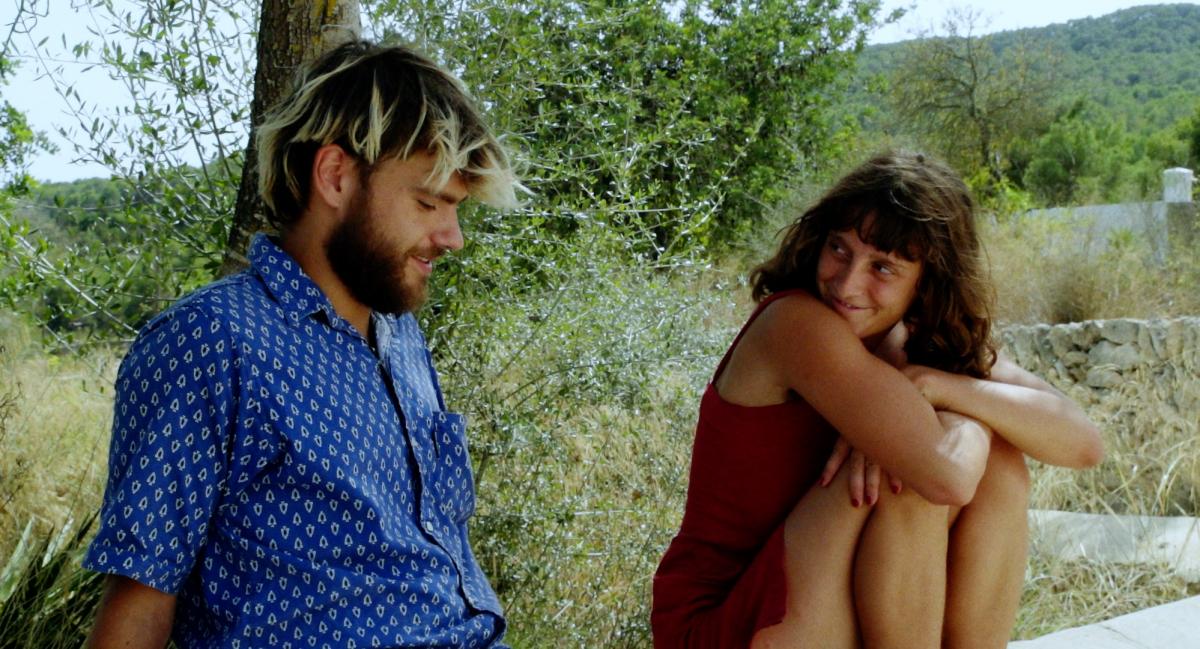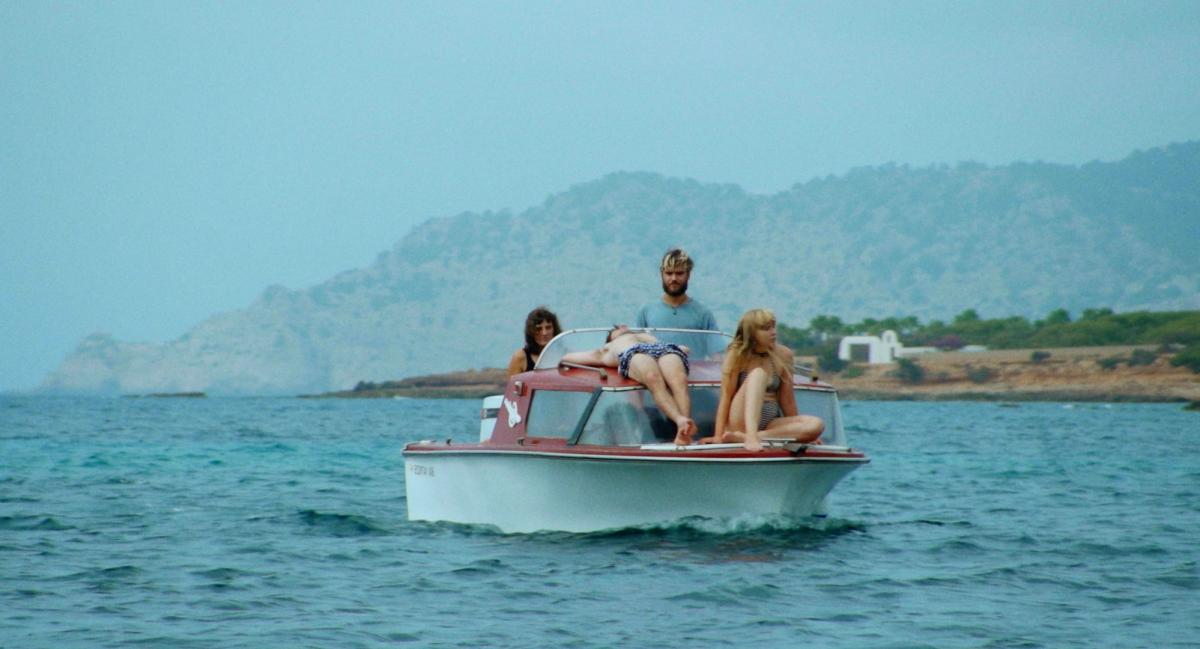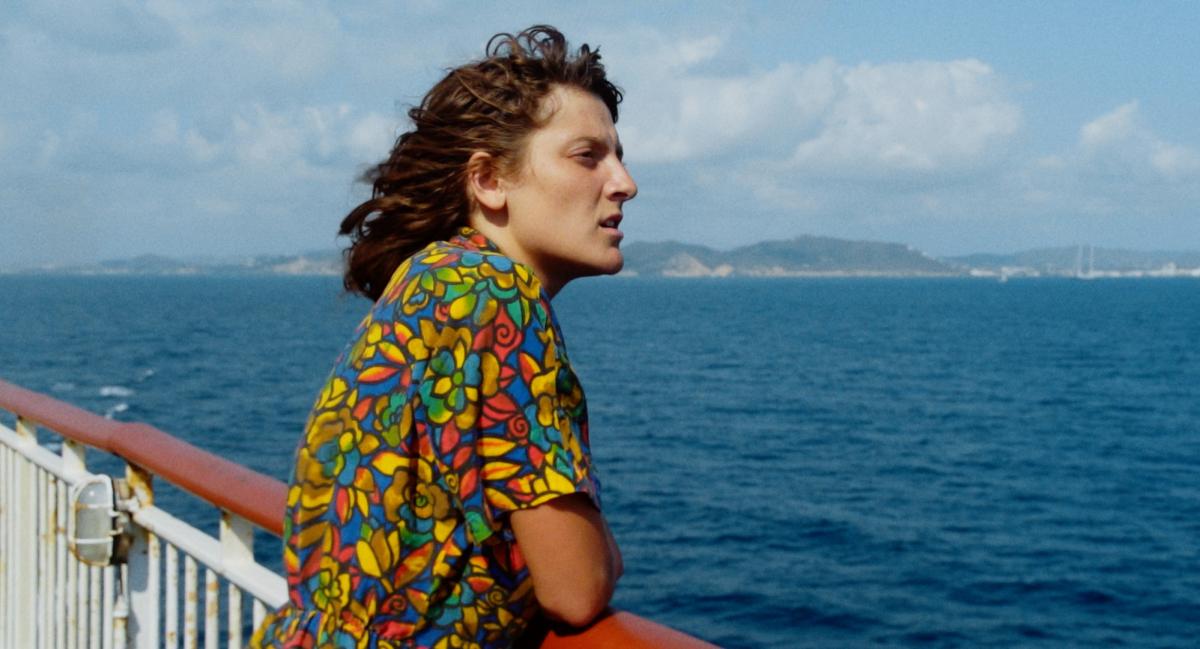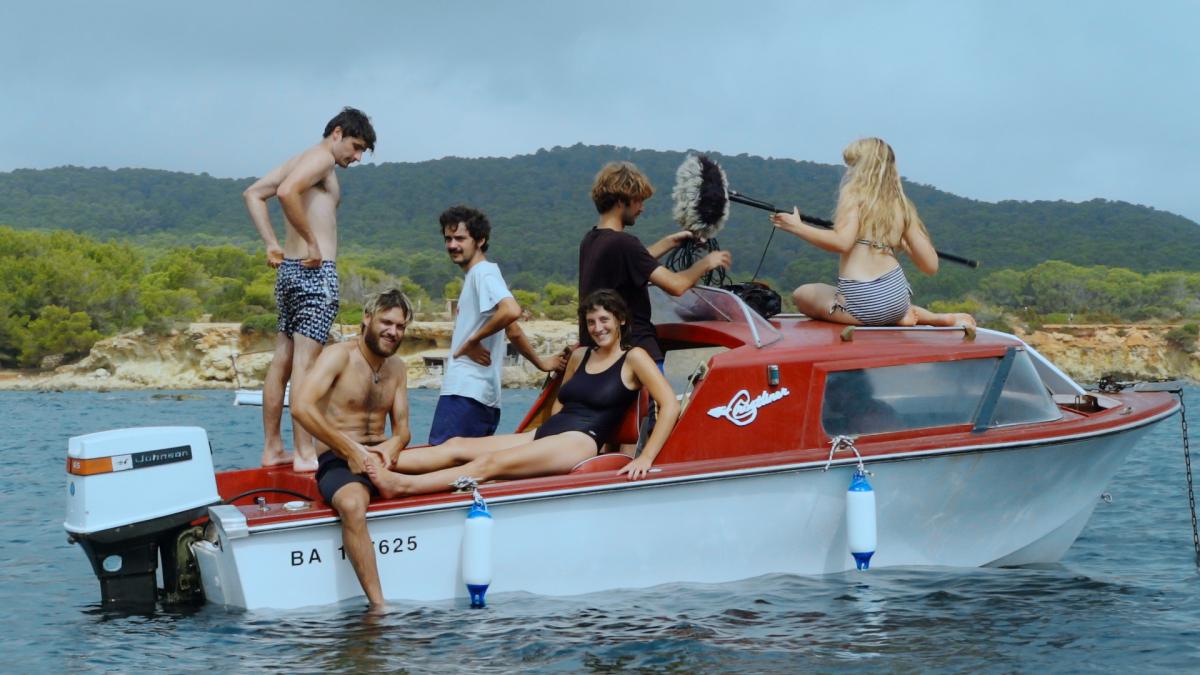After a Long Night
Interview with Mattéo Eustachon, One of the Directors of Mourir à Ibiza
Mattéo Eustachon, Léo Couture and Anton Balekdjian were students at Lyon’s CinéFabrique when they decided to make a film over the summer. That’s how the first part of the Mourir à Ibiza trilogy came about.
The film begins with Léna (Lucile Balézeaux) arriving at the Gare d’Arles, when she hesitatingly asks a passer-by for directions. It’s as if the story itself is arriving in this new place and starts to explore the space of the film in progress. In a series of tableaux vivants, the viewer follows Léna as she meets Maurice (Alex Caironi) and Ali (Mathis Sonzogni), while waiting for her friend Marius (Cesar Simonot).
Over the next two summers, in Étretat and then Ibiza, the protagonists meet again, and their relationship evolves. One year older, much has changed between the lines. Holidays are a time when everything is open, when anything seems possible... summer is the season of love, although this feature film is above all a portrait of four friends who dream.
Nina de Vroome met Mattéo Eustachon in Tui, Spain, after the screening of Mourir à Ibiza at the Play-Doc festival.

Sabzian: This film was made while you were students at the CinéFabrique in Lyon. Why did you decide, after a busy university year, to continue working over the summer and make this film together?
Mattéo Eustachon: The CinéFabrique is a great school because, as students, you get to make a lot of films and meet some very interesting people. It’s very fast-paced, with everyone making their own film, and you shoot one film while preparing the next. At that time, Anton had to make a period film with twelve actors and actresses, proper roles, not just extras. There were twenty-five crew members on set, including Léo on sound and me on camera. The constraints were such that we couldn’t explore everything we wanted to do, and that was extremely stressful. Anton, Léo and I were flatmates at the time, and one evening, on the terrace, while having a drink, we talked about our desires, our fears, and our inspirations. We were worried about graduating soon and not making films anymore. We were only in our second year, but we wanted to promise ourselves that we would make a feature film every year, every summer, so as not to lose the momentum. We’d just watched Eric Rohmer’s Conte d’été and couldn’t stop talking about it. We were fascinated by the way the film was written, its natural, spoken language, with a great mastery of rhythm and phrasing. It’s charming in its simplicity, follows the rhythm of daily life and is divided into chapters, according to the indication of the day.
We started imagining scenes all night long, thinking of a very simple shoot, with friends we wanted to film, in Arles because a friend might be able to put us up. By seven o’clock in the morning, we had the whole part that would take place in the town.
After that evening, we were once again swamped with work and a week before our departure for Arles, we met again to discuss the project. As we hadn’t had enough time to work out the full script, Anton had taken notes on the first evening and we were able to write a more or less precise sequence, with an overall idea of the situations and the trajectory of the film. Each scene was summarised in three lines with the story it was supposed to tell, it was very simple, there was no dialogue.
Once there, the actors joined us and chose the first name of their character, and we explained to them what we wanted to do. Some were more comfortable with dialogue, while others preferred to improvise. As we went along, we found what outlined each character, what made us laugh and what moved the film forward.
How do you know if a take is good?
Often, right from the first take, there’s something that disappears afterwards, that you can never find again. There are moments when the scene suddenly comes to life, it’s a feeling you get when you’ve managed to push the scene through to the end. Sometimes it’s quick, sometimes it’s long. The best takes are often the first or the last. For the key sequences, important for the narrative tension, we generally worked for longer. Sometimes we did as many as fifteen takes. We generally started shooting in the evening and continued until dawn. That was our only constraint: the path of the sun.
So you’re on camera, Leo is on sound and Anton is watching. The three of you do the editing.
Yes, and then there’s Manon, a friend who helped us a lot off set. With such a small crew, as with a documentary film, a lot can happen. We’re very discreet, we can film anywhere, go anywhere. People don’t take us seriously and think we’re making a holiday film. This lightness has allowed us to improvise, to turn round when something we hadn’t planned seemed more right, more interesting.
How do you choose your camera?
Each time, I have to find the right shooting equipment. I look for a configuration that allows me to do things differently, but without being too hampered by the equipment. It’s always that balance between being simple and being able to do complex things. It all has to fit into a little holiday rucksack. Returning to this economy, after shooting at school which required a lot of resources and equipment, allowed us to concentrate on what was essential. The acting.

Did you shoot a lot of scenes that didn’t make it into the film?
Our working method evolved between the first part in Arles and the last in Ibiza. In Arles, we worked more collectively. The actors could come up with more ideas, the schedule was less hectic, and we could afford to start shooting a sequence without knowing what it was going to say. Then, as we went along, the pace quickened, we knew better what we wanted, the working documents became more and more precise and sometimes there was even dialogue that we wrote the day before at short notice. As a result, in the third part, in Ibiza, the working method was less collective than at the beginning.
Of the shots taken in Arles, there’s almost no scene that isn’t in the film. We were very efficient and shot the bare minimum, without really knowing it. In Étretat, we left out more scenes, and in Ibiza even more.
I think it’s more logical to work the other way round: shoot a lot at the beginning because you’re still looking, and at the end, when you know what works, you become more efficient.
In Ibiza, we shot non-stop for eighteen days. When we edited this part, the first version was a feature film. That was fine, but it was different. We preferred the film to be made up of three parts that form a whole and wanted these three moments to show an evolution; this composition seemed more exciting to us. So when we were editing, we put the three films together. It was very interesting to make these three parts into a whole. We had to make sure that each one was linked to the next, without closing it off. It had to remain slightly open-ended, for rhythm's sake. We thought it would be a good idea to start each part with music and titles, a bit like a soap opera.
How did the editing go?
We filmed the first part, edited it, then filmed the second part, and so on. So, we had three short films of 45 minutes, 25 minutes and an hour and a half respectively. The three of us did the editing together for several months, but then the producers suggested that we work with someone from outside with a fresh eye and experience of feature films. It was with Juliette Alexandre that we put the three parts together. She had a very pertinent view of the film and was very persistent in editing with three directors in the same room.
The three parts were to become one unit.
Yes, it was mainly a question of rhythm. You get the impression that a single shot can throw the whole film off balance. It took a long time and we had to be very patient. It was good to work with three people, because if someone got discouraged, the others could give them energy. That keeps you going. The three of us support each other, but we’re also more demanding.
Why is filmmaking often seen as a solitary profession?
I think it’s rare and precious to find people with whom you can succeed in collaborating in this way. Often, it’s more natural to find your own universe and your own way of doing things, it can be very intimate. With a collective work, it’s more difficult to make a personal film, it’s a different energy.
But with Léo and Anton, have you found a way, a chemistry, that allows you to make personal films together?
Yes, I hope they are personal. We’re close, we’ve experienced things together that make us laugh, that move us. Even though we no longer live together, we continue to grow together, we continue to learn how to make films together, even if our personal styles are different. Sometimes we’re even opposed in our desires, but that’s not what we're looking for, to confront our respective personal styles, but rather what we share, what comes out of our discussions and our fears.
In each part, the characters are a year older. They’ve changed, as has the film itself. How would you describe this evolution? There’s no abrupt break, and yet the part in Ibiza is very different from the one you started in Arles.
It’s as if we’d started this film as children and finished it as adults. It’s the real passage of time. I think it’s impossible to cheat. Our desires have changed, our discussions have changed, and the actors have evolved. Personally, I was nineteen when we started and twenty-two when we finished.

These are important years.
I have the impression that we’ve lost some of our naivety. Before we started shooting, we hadn’t even thought about how we were going to produce the film. We invested 200 euros each, and when it turned out that wasn’t enough, we asked the actors if they wanted to contribute. Later, better prepared, there was also more investment. But I don’t think that really changed the way we worked. The constraint was to shoot, whatever happened, a fictional film in a documentary space: natural sets, extras who agreed to play along, tins as meals, and above all actors acting in real situations.
What changed was the preparation and writing time on location, prior to shooting. In Arles, we didn’t know anyone, the scenes weren’t very detailed, and we only met people during the shooting of a sequence. In Ibiza, we spent two weeks writing on location, trying to better integrate the people we met. The sequence was more precise. Most of the dialogue was summarized. Sometimes the actors would start a sequence with very little direction from us and it was only from take to take that we would clarify the sequences for them.
Previously, I hadn’t liked musical comedies at all, but this was a wonderful discovery. Perhaps that’s why we wanted to make this style our own. We didn’t make the actors dance, nor did we ask them to make big gestures, but we did leave an ambiguity about realism. Are they really singing, can they hear themselves singing or is it an inner voice singing?
The separation between the inner and outer worlds becomes blurred. There are also moments in the second half when this happens. When Ali is sitting alone and abandoned on the beach and Marius approaches him from the sea after a long boat trip, without saying anything. Marius gives Ali some stones and Ali throws them into the sea. It is as if Marius is somewhere between reality and an apparition, in the world and at the same time in Ali’s imagination.
It’s the strongest friendship scene in the film, because for me it's Ali thinking so hard about his friend that he makes him appear. After the part in Arles, which was very down-to-earth, we wanted to do something less concrete, to explore an inner world, a kind of magic. That’s how we started writing. The character of Ali is an archetype, he may seem very simple, but there’s something about him that fascinated us, that we wanted to explore.
He dreams a lot. He often feels out of place and uncomfortable, but it is he who has the greatest moment of happiness in the film. When he breaks into a cottage with Magda, she starts looking for valuables to steal. He follows her for a while, before exiting the chalet and dropping into the pool. As he floats in the water, he begins to sing. He seems liberated, all that matters is swimming in the night.
In this scene, we wanted Ali to dream about very simple things. Magda keeps taking him boating without telling him what she’s doing. Ali didn’t know they were going to break in. He follows her into the cottage, then into the backyard where there is a swimming pool. The image of the ideal holiday suited his character; we imagined him arriving in Ibiza with the dream of swimming in the pool of a big villa. He distances himself from the situation he finds himself in and enjoys a moment of happiness. This sequence was really born with the song. The songs also played a big part in the writing process. They were chosen and written beforehand and served as stages in the progression of the relationships between the characters.
Who wrote the music and lyrics?
There are songs we’ve covered, like ‘Ah que la vie est belle’ by Brigitte Fontaine, which Ali sings in the pool. And ‘À regarder la mer’ by Alain Barrière. Others were written with the actors.
Do you think the film is about happiness?
I hope so. I hope that happiness in the film consists simply of being together with friends and sharing things, but at the same time, in constant chaos. And having dreams. A friend of mine thought the film was utopian because the characters were not defined by social class or age. They’re twenty-five or twenty-seven like they could be eighteen and they seem to be working, but they don’t have real jobs. They embody a naive way of life.
They float.
We wanted the world of film to be a place where you want to live. A place where you have the freedom to search for yourself, with no obligation to succeed.
At the end of the film, Ali walks along the median strip between two motorways. He crosses it like a tightrope walker, looking for balance in his life and taking risks. How do you find this balance in the film, between very concrete, realistic moments and others that are more magical or symbolic?
I don’t know if we can really grasp what we’re looking for. We wanted to end with a sort of fireworks display, where everyone is involved in something very romantic. Realism was what structured the script, but magic was also very important. The musical moments were decisive in this respect. When you’re working on a film, there are a lot of things over which you have no control, especially when there’s no precise script. When you look at the rushes, you see the film in a whole new way. You get the feeling that it’s been built piece by piece. If there was a bad atmosphere on the set, you could feel it in the film. There’s something that comes from the experience of making the film. That’s the magic of filmmaking. What drives us to make films for the rest of our lives is the constant desire to do things differently, to do things better, to experiment. I can’t wait to see the next film we make.
Is each film a reaction to the previous one?
I think so. Because we make films as a threesome, there are a lot of things that remain mysterious and that we discover because we have a common universe, but each of us still has his own vision, which continues to surprise. In response to this film, the next one will take place in winter and in the mountains. What interests us is the diversity of characters you can meet in a ski resort; it’s about filming relationships that are created and sometimes unravel through a character trying to find its place in a world that seems to be at the end of its tether.

Images from Mourir à Ibiza (Un film en trois étés) (Anton Balekdjian, Léo Couture & Mattéo Eustachon, 2022)

